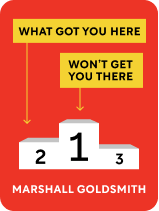

This article is an excerpt from the Shortform book guide to "What Got You Here Won't Get You There" by Marshall Goldsmith. Shortform has the world's best summaries and analyses of books you should be reading.
Like this article? Sign up for a free trial here .
What are the first steps to becoming a better leader? How can you avoid getting overwhelmed by the prospect of change?
In his book What Got You Here Won’t Get You There, Marshall Goldsmith discusses the difficulties of starting the process of change. He understands that many people are overwhelmed or scared by changes and he provides advice to help.
Here is Marshall Goldsmith’s advice if you want to know how to become a better leader.
Starting the Process of Change
You’ve gathered feedback from your colleagues. You’ve used that feedback to identify which bad habit you’re going to try to overcome. Now, it’s time to actually start the process of change: to begin to cut your bad habit out of your life.
If you want to know how to become a better leader, it’s important that you start the process of change as soon as possible after deciding which behavior you’re going to tackle. For example, don’t fall into the trap of putting change off until a time when you’re “less busy.” As an already successful person, you’re always going to be busy. Bite the bullet and start to cut out your bad behavior now. The sooner you start, the sooner you’ll begin to make progress.
The Practicalities of Change
Goldsmith doesn’t provide much information on the practicalities of making a behavioral change: for example, the steps you can take each day to reduce your temptation to engage in your bad habits and replace bad behaviors with healthier ones. Here are some practical tips we’ve devised to help you with this process:
- Each day, make a conscious effort to acknowledge and analyze each time you engage in your bad behavior. Record all of the details about the circumstances that preceded you slipping into your bad habit—for example, who you were with, what you were working on or talking about, and how you were feeling. This will help you to identify the triggers and patterns of your bad behavior. For instance, you might find that you’re at particular risk of acting harmfully when you’re stressed or starting to get tired at the end of the day.
- Once you’ve discerned the various triggers for your bad behavior, you can begin the work of actively stopping yourself from engaging in it. If you know that you’re about to enter a situation that, in the past, has led to you behaving badly, you can mentally prepare for this and consciously try to implement the alternative “healthier” behavior that corresponds to your bad habit.
- Successfully cutting out your bad behavior may be difficult at first. Habits are hard to break. But over time, behaving in a healthier way will become easier and easier.
How to Avoid Getting Overwhelmed
The idea of changing your behavior may seem incredibly overwhelming, especially if you decide to immediately jump from one behavioral extreme to another—for instance, from being a rude jerk who makes destructive comments all the time to being a benevolent boss who’s incredibly polite and kind. Making such a huge personality change might seem too difficult to achieve or too daunting to even attempt.
To avoid feeling overwhelmed, you could start the process of change by shifting into behaving neutrally— in a way that’s neither harmful nor “good.” In practice, this means cutting out your bad behavior without instantly trying to replace it with something “better.” For example, you could stop making destructive remarks to your colleagues without immediately switching to making lots of kind remarks.
While ”just” cutting out a bad behavior still takes a lot of work, it requires considerably less effort than ceasing a behavior and introducing a new one all at once. It’s therefore a much less overwhelming prospect.
The one caveat to this option is that it’s not always possible. Some behaviors simply don’t have a “neutral” option—you must either engage in the bad behavior, or switch to its positive equivalent. Take the example of the bad habit of refusing to listen to other people. The only way to overcome this bad behavior is to actively start listening to people. There’s no neutral, in-the-middle alternative action to choose here.
If you find yourself in a situation where you’re feeling overwhelmed at the prospect of transforming your behavior but have no “neutral” option to fall back on, try to remind yourself that while the change ahead of you will be difficult and take a lot of effort, it’ll be worth it in the end. With time and hard work, you will be able to successfully cut out your bad habit and introduce your new, healthier behavior.
Likewise, don’t put pressure on yourself to fully change your behavior overnight. Even if, at first, you only successfully implement your new, healthier behavior once each day, that’s still progress. This is a big transformation you’re making. Permit yourself to take your time with it.

———End of Preview———
Like what you just read? Read the rest of the world's best book summary and analysis of Marshall Goldsmith's "What Got You Here Won't Get You There" at Shortform .
Here's what you'll find in our full What Got You Here Won't Get You There summary :
- Why many middle managers find it hard to move up the corporate ladder
- The 21 harmful workplace behaviors keeping you from success
- How becoming too goal-oriented can actually harm your career






